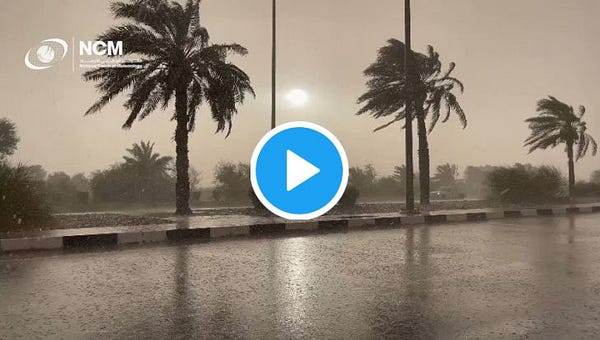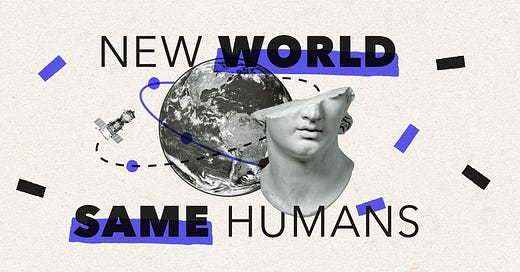Three Climate Stories
A snapshot of the climate crisis in 2021. And a glimpse of the future we will share.
Welcome to New World Same Humans, a weekly newsletter on trends, technology, and society by David Mattin.
If you’re reading this and you haven’t yet subscribed, join 17,000+ curious souls on a mission to build a better shared future 🚀🔮
🎧 If you’d prefer to listen to this week’s instalment, go here for the audio version of Three Climate Stories. 🎧
I’m back from a week beside the sea!
There’s nothing like a few days away from the desk to prompt new thinking. As you’d expect, I took the chance to ponder the future of our community. It’s about time I wrote an update on the state of the NWSH union, including new projects in the works. Expect that instalment soon.
In the meantime I’m picking up where I left off, with the greatest shared challenge we face: global heating. You can think of this instalment as something of a companion to the last Sunday note, Is This the Climate Turning Point?
Three climate stories caught my eye this week.
Each is a telling glimpse of the crisis as it is manifesting in 2021. And each points towards a broader set of issues that we must confront if we’re to address a heated world in the 21st-century.
🗺️ Mapping climate justice
We all know that the nations most responsible for global heating won’t be the only, or even the worst, affected by its consequences. But what if we could visualise that disparity?
Now, thanks to new research by the Monterey Bay Aquarium in California, we can.
Scientists at the Aquarium mined historical data sets on carbon dioxide, methane, and other warming agents, and combined them with projections of future warming developed by the Intergovernmental Panel on Climate Change.
The result is a map in which the nations most responsible for emissions are blue, while those that will heat the most glow a deep red.
It’s a stark visualisation – the first of its kind – of the global injustice baked into climate change. The map shows that just 8% of the planet’s surface, overwhelmingly in western Europe, north America, and eastern China, are responsible for 90% of the emissions that cause heating. But those set to be most affected are responsible for little or no emissions. What’s more, they include central African and Asian countries that are among the world’s poorest.
Back in NWSH #36 I wrote on how the Global North was built on carbon, and the Global South is set to pay the price. Here is a single image that encapsulates that truth.
It’s a map that all of us in the Global North have a duty to familiarise ourselves with. And it brings into sharp focus a set of questions that will loom ever larger over us in the decades ahead.
What do those in the rich world owe those elsewhere who have profited little from the carbon-fuelled industrial era, but are set to suffer the most from heating? And when hundreds of millions of the world’s poorest are forced to migrate out of areas that have become uninhabitable due to climate change, how should the Global North respond?
As yet, our search for answers remains in its infancy. But news came this week of one initiative that signals a way forward.
🌳 Cash for carbon sinks
Gabon has become the first country to be paid for taking action to slow deforestation.
The payments came via the Central African Forest Initiative (CAFI). Launched by the UN in 2015, CAFI is a project that sees a conglomerate of rich nations – including the UK, Germany and France – offer monetary incentives to countries in Central Africa that act to protect their forests.
Central Africa is home to the second largest rainforest in the world, after the Amazon. And because rainforests absorb and store carbon, halting tropical deforestation and allowing regrowth could mitigate up to 50% of net global emissions to 2050 according to the Rainforest Trust.
Gabon was paid $17 million for protecting its forest. And it stands to take a further $133 million in coming years if it stays on track.
The broader lesson here? The CAFI initiative reiterates a truth made clear by the Monterey Bay Aquarium map. That is, global heating embarrasses the nation state: the impacts of climate change respect no national boundaries.
Rainforests are a case in point. The world is dependent on a handful of governments in Central Africa plus Brazil to protect 75% of the world’s remaining rainforest. If they fail, the consequences for all of us will be dire. Not only does deforestation prevent rainforests from absorbing any more carbon, it also causes them to pump all the carbon they’ve ever absorbed back into the atmosphere. We don’t fully understand the consequences of that for global temperatures, but they’re likely to be severe.
CAFI points the way towards new models that accommodate the planetary interdependence that is our new reality. What about CAFI-like frameworks that pay the nations of the Global South for transitioning to clean energy, or preparing for the impacts of a heated world?
Informing all these models should be a simple principle. That is, the transfer of wealth from those countries historically most responsible for global heating, to those set to suffer most from its impacts.
So far, the global record on that isn’t good. At the 2009 climate talks in Copenhagen, rich nations agreed to pay $100 billion by 2020 to help poor nations adapt to climate change. To date, they’ve paid around one third of that.
🌧️ Make it rain
The UAE is using drones to create artificial rain.
The country’s National Centre of Meteorology is sending drones into clouds, where they release an electric charge that causes water droplets to clump together, making rain more likely.
Regional newspaper Gulf Today says 126 drone flights have been conducted this year, including at least 14 this month. And they have resulted in scenes such as this one in Dubai:


The UAE averages just 100mm of rain per year (for context, the admittedly rainy UK gets 1,300mm).
Meanwhile, average temperatures are 1.5 degrees higher than they were 60 years ago. This summer the nation has suffered through a brutal heatwave; earlier this month town of Sweihan, in Abu Dhabi, recorded a temperature of 51.8C.
Now, high temperatures are causing the water table to sink, threatening a chronic drought. The new cloud seeding experiments are, say authorities, an attempt to reverse some of this change.
Back in NWSH #60 I wrote about the search for tech-fuelled solutions to climate change, including a Bill Gates-sponsored experiment in spreading chalk dust across the sky to reflect sunlight.
A fierce debate rages around these approaches. Are they really the answer to a warming world? Or will they only divert our attention away from necessary but painful steps to change our industries, consumption, and lifestyles?
That debate will continue. But the UAE’s summer of drone-rain is a signal of what lies ahead. As the climate crisis becomes more urgent, expect more state-fuelled climate experiments sooner rather than later.
Calling planet Earth
Thanks for reading this week.
Climate change is an empirically observable reality. We even understand the fundamental mechanisms driving it.
It’s when that reality – when the truth of what we’ve done – collides with human nature that the picture becomes complex. We know systemic change is necessary. But how do we effect it? Who pays the price? Who wins, and who loses?
This kind of collisions – between a changing world and age-old human nature – are exactly the stories New World Same Humans was set up to track.
And there’s one thing you can do to help with that mission: share!
If this week’s instalment resonated, why not take a second to forward this email to one person – a friend, family member or colleague – who’d also find it valuable? Or share New World Same Humans across one of your social networks, and let people know why it’s worth their time. Just hit the share button!
Your membership of our community is valued. I’ll be back on Wednesday; until then, be well.
David.





